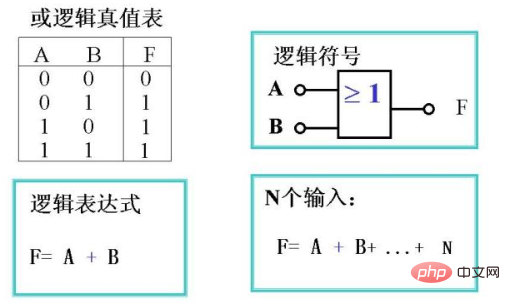What are the three basic logical operators?

Logical algebra has three basic logical operations: AND, OR, and NOT. It is algebra that operates according to certain logical relationships, and is a mathematical tool used to analyze and design digital circuits. In addition, the logical AND operation of logical variables is called the AND term, and the logical OR operation of the AND term constitutes the AND or expression of the logical function, which is also called the sum of products expression.
There are three most basic logical operations:
1) Logical AND - represented by AB: when A and B are both 1, its value is 1, otherwise it is zero;
2) Logical OR - use A B to express: when A and B are both 0, its value is 0, otherwise it is 1;
3) Logical NOT - use '¯' on A Indicates that when A=0, the non-value of A is 1, and when A=1, the non-value of A is 0.

Extended information:
Using the basic formulas and rules of logical algebra, the logical function can be transformed to obtain the expression of Simplest form. The so-called simplest form here refers to the simplest AND-OR formula or the simplest OR-AND formula. There are two criteria for judging them: the least number of terms; under the condition of the least number of terms, the least words in the terms.
The Karnaugh map is formed according to certain rules. Due to these laws, many characteristics of logical algebra are vividly and intuitively reflected in graphics, making it a powerful tool for formula proof and function simplification.
The above is the detailed content of What are the three basic logical operators?. For more information, please follow other related articles on the PHP Chinese website!

Hot AI Tools

Undresser.AI Undress
AI-powered app for creating realistic nude photos

AI Clothes Remover
Online AI tool for removing clothes from photos.

Undress AI Tool
Undress images for free

Clothoff.io
AI clothes remover

Video Face Swap
Swap faces in any video effortlessly with our completely free AI face swap tool!

Hot Article

Hot Tools

Notepad++7.3.1
Easy-to-use and free code editor

SublimeText3 Chinese version
Chinese version, very easy to use

Zend Studio 13.0.1
Powerful PHP integrated development environment

Dreamweaver CS6
Visual web development tools

SublimeText3 Mac version
God-level code editing software (SublimeText3)

Hot Topics
 1387
1387
 52
52
 Python Operators: The Ultimate Guide from Newbie to Master
Mar 11, 2024 am 09:13 AM
Python Operators: The Ultimate Guide from Newbie to Master
Mar 11, 2024 am 09:13 AM
Introduction to python operators Operators are special symbols or keywords used to perform operations between two or more operands. Python provides a variety of operators covering a wide range of uses, from basic mathematical operations to complex data manipulation. Mathematical operators Mathematical operators are used to perform common mathematical operations. They include: operator operation examples + addition a + b - subtraction a-b * multiplication a * b / division a / b % modulo operation (take the remainder) a % b ** power operation a ** b // integer division (discard the remainder) a//b Logical Operators Logical operators are used to concatenate Boolean values and evaluate conditions. They include: operator operations examples and logical and aandbor logical or aorbnot logical not nota comparison operations
 What are the logical operators in Python?
Oct 18, 2023 am 11:05 AM
What are the logical operators in Python?
Oct 18, 2023 am 11:05 AM
What are the logical operators in Python? Logical operators in Python are used to logically compare expressions and return a Boolean value (True or False). There are three commonly used logical operators in Python: and, or and not. and operator and operator is used to check whether all operands are true (True). The and operator returns True only if all operands are true; otherwise it returns False. Here is a sample code: a=10b=
 The Secret Garden of Operators: Discover Hidden Treasures in Python
Mar 11, 2024 am 09:13 AM
The Secret Garden of Operators: Discover Hidden Treasures in Python
Mar 11, 2024 am 09:13 AM
The Secret Garden of Operators Python operators are symbols or keywords used to perform various operations. They enable developers to express complex logic concisely and clearly and improve code efficiency. Python provides a wide range of operator types, each with its specific purpose and usage. Logical Operators Logical operators are used to combine Boolean values and perform logical operations. The main ones are: and: Returns the Boolean value True, if all operands are True, otherwise it returns False. or: Returns a Boolean value True if any operand is True, otherwise returns False. not: Negate the Boolean value, change True to False, and change False to True. Demo code: x=Truey
 How to correctly use the logical OR operator in C language ||
Mar 29, 2024 pm 12:45 PM
How to correctly use the logical OR operator in C language ||
Mar 29, 2024 pm 12:45 PM
Title: How to correctly use the logical OR operator || in C language. In C language, the logical OR operator || is a commonly used logical operator, which is used to determine whether any of the conditions is true. Proper use of logical OR operators can help us write more concise and efficient code. The following will introduce in detail how to correctly use the logical OR operator || in C language and provide specific code examples. The basic syntax of the logical OR operator || is: expression 1 || expression 2. When either expression1 or expression2
 Uncovering the Power of Python Operators: Writing Elegant and Efficient Code
Mar 11, 2024 am 09:28 AM
Uncovering the Power of Python Operators: Writing Elegant and Efficient Code
Mar 11, 2024 am 09:28 AM
Python operators are a key component of the programming language, enabling developers to perform a wide range of operations, from simple arithmetic to complex bit manipulation. Mastering the syntax, semantics, and functionality of operators is essential to using Python effectively. Arithmetic Operators Arithmetic operators are used to perform basic arithmetic operations. They include addition (+), subtraction (-), multiplication (*), division (/), modulo (%), exponentiation (**), and floor division (//). The following example demonstrates the use of arithmetic operators: >>a=10>>b=5#Addition c=a+bprint(c)#Output: 15#Subtraction c=a-bprint(c)#Output: 5#Multiplication c=a*bprint(c)#output
 Secrets of Python Operators: Mastering the Cornerstone of Programming
Mar 11, 2024 am 09:19 AM
Secrets of Python Operators: Mastering the Cornerstone of Programming
Mar 11, 2024 am 09:19 AM
Python operators are special symbols or words used to perform specific operations on values or to combine values. They are the fundamental building blocks of programming languages and are key to understanding and writing efficient code. Arithmetic Operators Arithmetic operators are used to perform basic mathematical operations such as addition, subtraction, multiplication, division, and remainder. The following are the most commonly used arithmetic operators: +Addition-Subtraction*Multiplication/Division%Remainder Example: x=10y=5print(x+y)#Output: 15print(x-y)#Output: 5print(x*y)#Output :50print(x/y)#Output: 2.0print(x%y)#Output: 0 Comparison Operator The comparison operator is used to compare two values and return a Boolean value (True
 An in-depth understanding of Python operators: a practical guide to bitwise operators, logical operators, and operator precedence
Jan 20, 2024 am 09:51 AM
An in-depth understanding of Python operators: a practical guide to bitwise operators, logical operators, and operator precedence
Jan 20, 2024 am 09:51 AM
Application of Advanced Python Operators: Practical Guide to Shift Operators, Logical Operators, and Operator Priority Python is a high-level programming language widely used in various fields, and it is very important to master the use of operators. In addition to basic arithmetic operators, Python also provides many other types of operators, including bitwise operators, logical operators, etc. This article will delve into the application of these operators and provide specific code examples to help readers better understand and use them. 1. Bit shift operator bits
 Java regular expression logical operators
Aug 30, 2023 am 09:45 AM
Java regular expression logical operators
Aug 30, 2023 am 09:45 AM
JavaRegularexpressionssupports3logicaloperatorstheyare−XY:XfollowedbyYX|Y:XorY(X):capturinggroup.XY:XfollowedbyYThissimplymatchestwosingleconsecutivecharacters.Example LiveDemoimportjava.util.Scanner;importjava.util.regex.Matcher;i



